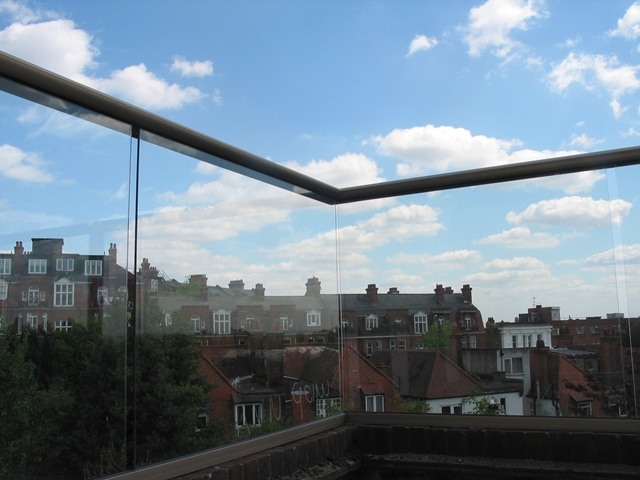Deterioration of glass surfaces and facades
Glass Balustrades | Juliet Balconies | Galleries | Articles | Case Studies
Glass surface corrosion
Did you know that water causes surface corrosion on glass?
Water and surface corrosion on glass, invisible as it may seem, degrades the surface of glass and over time will become more and more noticeable. New solutions using advanced hydrophobic glass coating allow protecting these surfaces, making them, to some degree, self-cleaning and keeping the glass looking newer for longer.
Why does new glass loose its sparkle?

New glass is bright and sparkling, easy to see through and easy to clean and keep clean. Contrary to popular belief, the surface of the glass is not completely smooth. It has what glass manufacturers call 'lattice' or 'honeycomb' patterns. Under a microscope, glass reveals a rougher surface made of peaks and potholes.
Organic and inorganic contaminants fill these potholes and react chemically with the glass, firmly bonding to its surface. As a result, glass easily becomes stained, opaque and discoloured, difficult to see through and difficult to clean and keep clean.
Glass surfaces naturally possess hydrophilic (water attracting) properties and over time is subjected to a corrosion process that will make its surface rougher and therefore its damage greater, in some cases irreversibly so.
Glass is more resistant to corrosion than most materials, so much so that it is easy to think of it as almost corrosion-proof. However glass balconies, in particularly in marine environments, after only several months’ exposure to the elements do not always remain clear and unaffected. This has great implications on the property owner and any other users of glass, increased costs and efforts in maintenance, renovation or replacement, and in all cases a reduction in the expected performance.
Just as metal rusts, glass is subjected to a corrosion process caused by reactions between the glass surface and gases in the atmosphere. It is commonly associated with moisture or vapour attack through condensation, or reaction with an alkaline solution.
Glass naturally attracts water (i.e. is hydrophilic), meaning it attracts and holds moisture. All glass has a molecular layer of moisture on the surface. When this layer increases because of humidity or rainfall, it can obscure visibility and create a risk to comfort or safety. But most of all, it participates greatly to the destruction of the surface of the glass.
Unprotected glass
Ordinary, unprotected glass is not hygienic. An alternative to using potentially hazardous chemical disinfectants is frequent and intensive washing with water and detergents. However, this approach is high-maintenance, labour-intensive and, if the use of detergents and water consumption is not controlled, cannot be considered as either green or hygienic.
It is difficult – sometimes impossible – to clean, keep clean and disinfect ordinary glass. Even when new, glass is microscopically rough with countless places for bacteria to hide and multiply. With exposure to alkalinity from industrial cleaning products and moisture, both liquid and vapour, the surface of unprotected glass becomes corroded and even rougher. Also, unprotected glass chemically reacts with contaminants, such as hard water deposits, which bond firmly to glass – making it even more difficult to clean, keep clean and disinfect.
Advances in glass protection
Glass usage in the country has been growing dramatically over the past decade. We all like our houses and buildings to open up to the environment and be flooded with natural light. Architects and decorators are innovatively using glass for a variety of applications from skylights to partitions, balustrades to staircases, and many more that make our surroundings look more spacious and beautiful. In the past, this has led to a trade off with safety, security, energy efficiency, and noise insulation.
Glass is more than functional; it is architectural. It gives the illusion of more space, increases natural lighting, and lends character to interior spaces. Architectural glass goes beyond architecture to become art, using textures, patterns, colours, and technique to define and highlight individual tastes.
Whichever glass you speak about, without surface protection it will always be left exposed to the natural elements and invariably corrode or degrade.
Glass protection in the form of silica based coatings is becoming more and more popular and readily available creating a sort of “self cleaning” face that protects the glass from corrosive elements plus turns the natural hydrophilic face of glass to hydrophobic, making it water repellent and causing water drops to “curl” up and run off, rather than spreading out and depositing in the invisible rough face of glass.
Solution for glass protection on Balconies
Here at Balcony Systems we have been offering a very unique and cost effective solution to glass protection to Balcony glass. This can either be purchased as an OEM solution applied to the glass at the factory and supplied as part of the order, or in cases where the balconies are already installed this can be applied as a “retro fit” solution.
This unique glass coating solution is branded as BalcoNano®. For more information on Balcony Systems’ self-cleaning glass coating click here www.BalcoNano.com








